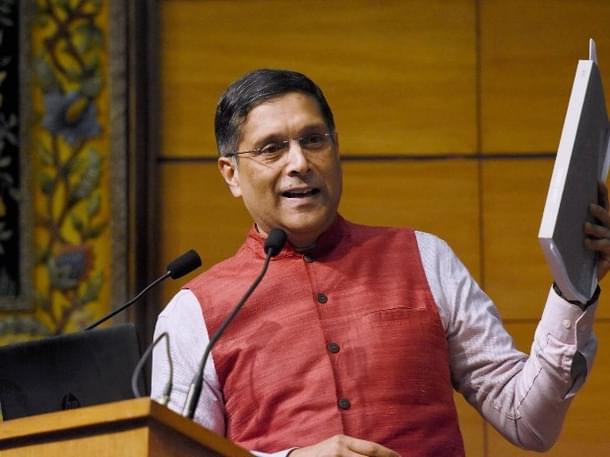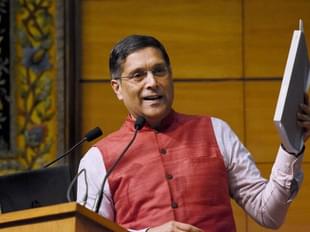Current Affairs
Morning Brief: A Special Report On What You Need To Know About India’s Economic Survey 2017-18
Swarajya Staff
Jan 30, 2018, 06:45 AM | Updated 06:45 AM IST
Save & read from anywhere!
Bookmark stories for easy access on any device or the Swarajya app.


Good morning, dear reader!
Today we have assembled for you a bouquet of news articles and opinion pieces on the Economic Survey 2017-2018 authored by Chief Economic Adviser Arvind Subramanian and tabled by Finance Minister Arun Jaitley in Parliament yesterday (Monday) in the run-up to the Union budget.
Three of Swarajya’s in depth analyses on the survey, a precursor to the budget that will be presented on 1 February, list positives and worries for an economy that withstood major reforms like goods and services tax (GST) and demonetisation.
Here’s A List Of Tell-All Articles We Have Put Together For You:
A highlight of the survey is the shrinking of the informal sector, which is good news as it is often characterised by low tax compliance, low respect for basic labour laws, and low concern for environmental pollution, explains Swarajya’s editorial director R Jagannathan in his engrossing article.
In yet another engaging write-up, he draws attention to ease of doing business and suggests that India’s judiciary reads through the Economic Survey to understand the worrying implications of delaying economic cases and get its priorities right. It is time to move away from BCCI and Diwali crackers to more urgent issues concerning the exchequer and the taxpayer, he writes.
Senior journalist Sindhu Bhattacharya in her column, says policy vigilance is essential in the coming year in line with the survey that has cautioned against policy complacency, especially against the rapid rise in stock market valuations and the heating up of oil prices in the international market.
Some Of The Other Stories That Swarajya Curated For You…
Economic Survey Projects India’s FY19 Growth At 7-7.5 Per Cent, Fiscal Deficit At 3.2 Per Cent: The survey tabled on the first day of the Budget session, says the economy is expected to expand at 7-7.5 per cent in the financial year 2018-19. It also noted that the economy is likely to grow at 6.75 per cent in 2017-18 against 6.5 per cent estimated by the Central Statistics Office. “A series of major reforms undertaken over the past year will allow real GDP growth to reach 6.75 per cent this fiscal and will rise to 7 to 7.5 per cent in 2018-19, thereby re-instating India as the world‘s fastest-growing major economy,” it said. The survey puts fiscal deficit at 3.2 per cent.
How Government Package Of Rs 6,000 Crore To Apparel Sector Boosted Readymade Garment Exports: The Economic Survey has established that the implementation of Rs 6,000 crore package, announced for the apparel sector on June 2016, has provided an impetus to the exports of readymade garments (RMG) of man-made fibres. The apparel sector has immense potential to drive economic growth, increased employment and empower women in India, said the report, and added the potential for the sector has increased with China’s share of global apparel exports coming down in recent years. However, India has not, or not yet, capitalised on this opening, resulting in countries like Vietnam and Bangladesh quickly filling the vacuum left by China.
Impact Of DeMo And GST: India Added 40 Lakh New Filers To The Tax Base: The introduction of goods and services tax (GST) and demonetisation of high-value currency notes brought significant number of people into the income-tax net, revealed the Economic Survey. "One of the aims of demonetisation and the GST was to increase the formalisation of the economy and bring more Indians into the income tax net, which includes only about 59.3 million individual taxpayers (filers and those whose tax is deducted at source in 2015-16), equivalent to 24.7 per cent of the estimated non-agricultural workforce," said the report. After November 2016, 10.1 million filers were added compared with an average of 6.2 million in the preceding six years, an addition of 40 lakh people.
New Employment Survey Underway: NITI Aayog Urged To Make Timely Data Available: A comprehensive survey of employment is underway following the Union government authorising its premier think tank NITI Aayog to issue new guidelines to make timely data available for employment assessments, said the Economic Survey. In the intervening period, the digitisation of government data and the introduction of the GST have provided an opportunity to make some preliminary estimates of formal employment, it said.
Ten New Facts About The Indian Economy From The Economic Survey: The survey listed 10 new observations that are important to the Indian economy. Some of them are, a significant rise in registered indirect and direct tax-payers; formal non-agricultural payroll was much greater than what was believed; how a set of select states are driving India's exports and impact of climate change on agricultural yields.
Economic Survey Calls For A Different Approach To Irrigated And Non-Irrigated Farming: The survey says the Centre will have to make a clear distinction between two types of agriculture in India for better yields. One is well-irrigated, input-added, and price-and-procurement-supported cereals grown in Northern India – where the challenge is for formulation of a policy to change the form of the generous support from prices and subsidies to less damaging support in the form of direct benefit transfers. The other type of agriculture deals with non-cereals in central, western and southern India where the problems are inadequate irrigation, continued rain dependence, ineffective procurement, and insufficient investments in research and technology, among others. The report is significant since 52 per cent of area under agriculture in the country is still rain-fed and unirrigated.
Five Reasons Why India’s Growth Has Moved In Opposite Direction To That Of Global Growth Until Now: The Economic Survey explains the factors that nudged India into paving a unique growth trajectory following the “decoupling” of India’s growth from the world’s. The survey said until early 2016, India’s growth had been accelerating when growth in other countries was decelerating. But then the reversal happened. The world economy started on a synchronous recovery, but India’s gross domestic product growth — and indeed a number of other indicators such as industrial production, credit, and investment — decelerated. Here, the survey identifies five reasons that caused India to forge its own unique path.
Economic Survey 2017-18: Indian Carriers Leave Behind China, US In Domestic Departures: The survey indicates that India has emerged as the third largest and the fastest growing domestic aviation market in the world, recording a 23.5 per cent growth in the number of domestic departures for the year 2016-17. The annual growth in domestic passenger departures in India was 23.5 per cent as compared to 3.3 per cent in the United States and 10.7 per cent in China. The survey also states that the domestic carriers transported 5.75 crore passengers in during April-September 2017-18 which represents a year-on-year growth of 16 per cent.
Six States That Account For 75 Per Cent Of India’s Exports: The Economic Survey says that for the first time ever there is an opportunity to know the state-wise distribution of international exports of goods and services. Six states — Maharashtra, Gujarat, Karnataka, Tamil Nadu, Telangana and Haryana — in that order account for 75 per cent of India’s exports, says the survey. The export data for individual states also reveal that the prosperity of states is related to their export performance. Additionally, GST data suggests that India’s internal trade in goods and services (excludes non-GST goods and services) is about 60 per cent of the GDP.
MUST READ OPINIONS AND COLUMNS
The Economic Survey: An Overview: As in last year’s survey, Big Data has been mined to shed light on the economy, and there have been some moments of epiphanic understanding, writes India’s Chief Economic Adviser Arvind Subramanian.
Revival And Risk Are The Twin Messages Of The Eco Survey 2018: Fiscal prudence and a continuation of the reform programme are the two takeaways from the Economic Survey 2018.
We hope you enjoyed reading our morning brief. Have a great day ahead!
SUBSCRIBE NOW: The January issue of our magazine is out now. The cover story focuses on the strategy for 2018 that will confront Narendra Modi in April-May 2019, and at the same time focus on a strong economic and governance agenda in the final year of his tenure – Do The Right Things. For more insights and detailed analysis get a copy home and enjoy reading Swarajya in print. Subscribe here to start receiving your copies for just Rs 349.
Swarajya Apps: Enjoy reading morning brief and all other articles from Swarajya on your mobile. Download our app here on Android and iOS.





